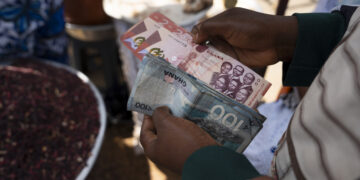Chart of the Week: Dollar’s Share of Reserves Held Steady in Second Quarter When Adjusted for FX Moves
Our unique data on the currency composition of global foreign exchange reserves, COFER, track how much of the world’s reserves are held at central banks in different currencies—such as the US dollar, the euro, Japanese yen, Chinese renminbi, British pound, and others. The data are based on voluntary, confidential reports by 149 economies.
But a crucial detail is often overlooked: these shares are reported in US dollars. This means that if a country holds reserves in euros or yen, the value of those holdings is first converted into dollars before being added to the global totals. So, when exchange rates shift—even if no central bank buys or sells anything—reported shares change. The same can happen with movements in interest rates, but the impact on the currency shares was relatively small in the second quarter.
This year, exchange rate shifts have been noticeable.
- The DXY index—a benchmark measure of the US dollar’s performance against the euro and the currencies of Japan, the United Kingdom, Canada, Sweden, and Switzerland—fell more than 10 percent in the first half of the year, its biggest drop since 1973.
- The dollar depreciated by 7.9 percent against the euro in the second quarter, and by 10.6 percent in the first half.
- Itfell by 9.6 percent against the Swiss franc in the second quarter, and by more than 11 percent in the first six months, its weakest first-half performance against the franc in more than a decade.
This means that even if central banks made no changes to their portfolios, the value of their non-dollar holdings—when expressed in dollars—increased, resulting in a corresponding decrease in the share of dollar holdings.
At first glance, the raw data suggest a drop in the dollar’s share of allocated reserves to 56.32 percent at the end of the second quarter from 57.79 percent at the end of the first quarter, down 1.47 percentage points. However, by holding exchange rates constant, its share would have fallen only slightly to 57.67 percent.
As the Chart of the Week shows, currency movements explain 92 percent of the reduction of the dollar’s share during the three months through June. Similar exchange rate effects can be seen in other currencies, including for the euro, the world’s No. 2 reserve currency.
The share of claims in the euro appears to have surged to 21.13 percent in the second quarter, from 20.00 percent in the prior three months, up 1.13 percentage points. However, valuation effects were responsible for 1.17 percentage points of this, more than the movement itself. If exchange rates had held steady, the euro’s share would have fallen by 0.04 percentage points to 19.96 percent in the second quarter. Here, the valuation effect effectively obscures the direction of change of the underlying movement in the currency. Similarly for the pound: the valuation effect obscures the direction of change: the share appears to have gone up when, holding exchange rates constant, the share would actually have gone down.
In a dynamic global landscape, correctly gauging reserve data is more crucial than before. Our exchange-rate-adjusted COFER figures offer a more nuanced account of how central banks are managing their portfolios and what that means for the global financial system. The latest reserves data, once adjusted for exchange rate changes, suggest that the dollar share of central bank reserve holdings has not declined to the extent that unadjusted figures signal at first.








